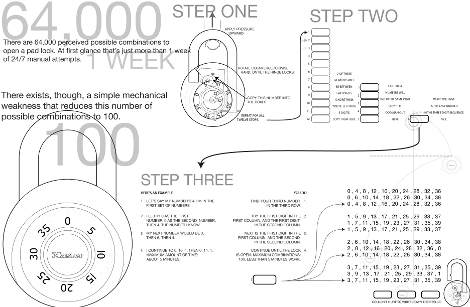Long, long ago we covered a method to crack a Master lock in about 30 minutes or less. Here’s a revival of the same method but now the instructions to retrieve the combination are in info-graphic format created by [Mark Edward Campos].
If you didn’t get to try this the first time around, here’s how it works: A combination of a physical vulnerability, math, and brute force is used. First, the final number of the code can be obtained by pulling up on the latch while the dial is rotated. Because of the way the lock is built the correct number can be extrapolated using this trick. Secondly, a table of all possible first and second number combinations has been calculated for you. Third, it’s your job to brute force the correct table of possibilities which includes only about one hundred combinations.
We’re not really into felony theft and hopefully you’re not either. But, we have a nasty habit of needing to use a combination lock that’s been in a drawer for a few years and having no idea of what the correct code might be.
Update: We’ve had a lot of comments about shimming as a better method. For your enjoyment we’ve embedded a video after the break that details how to shim a Master lock using a beer can. Just remember: friends don’t let friends drink and shim.
[youtube=http://www.youtube.com/watch?v=bXRUd63ycTU]















Master Lock has redesigned their combination padlocks with an anti-shim mechanism. The locks look superficially the same and still have the same model numbers. The brute force method using the number table may be the best bet again.
I just had $500 stolen from me most likely using this method. Someone shimmed my lock at the gym and is no doubt buying some meth right now.
This doesnt work. I tried every combo twice and still couldnt get my lock to open. I think this is some joke to get people to waste time, not very funny if you ask me.
Step 1. grab a metal object similar to a master lock,
Step 2. hold it firm and turn it around,
Step 3. SMASH IT with the metal object and boom it opens, bare in mind there will be a dent.
thanks
wrong number in serie one, two and three
serie one
0-4-8-..
2-6-10-.. <== 0 must be 2
0-4-8..
serie two
1-5-9-..
3-7-11-.. <== 1 must be 3
1-5-9-..
serie three
2-6-10-..
0-4-8-.. <== 2 must be 4
2-6-10-..
serie four
3-7-11-..
1-3-9-..
3-7-11-..
note: plus 4 for next number.
Didn’t work for me. Third number was tough to get as some of my sticking points were more like x.25 or x.75. Didn’t have exactly 7 that I could cross out, so had to guess, and came up with 36.
Then I went through the table – twice – to get the combo -never worked.
The graphic is wrong. You need to add two to every number on the second row for all four groups. I went through the graphic twice and couldn’t get my lock open but once I read the comments and added two to every number on the second row it worked. Alternatively, the website referenced (joeshamah.com/projects/master-lock-calculator/) is great as long as you know the last number.
The table is wrong livefree75. You have to add 2 to every number in the second row. If you think you know what the last number is, try this site: joeshamah.com/projects/master-lock-calculator/. It’s how I figured out the table was wrong.
will somebody please address the locks that do Not click or stick or latch while pulling on the hasp? no matter how hard you pull or push on the hasp there is no where on the dial where it “sticks”
I can’t believe it but it works. Just do steps 1-3 to get the last number and go to the page recommended by Mr. Somebody in a post above http://joeshamah.com/projects/master-lock-calculator/ It took me 20 minutes while watching the Penguins-Islanders hockey game!
could anyone here help me i have been searching for days and found nothing i have just moved into as new housde and there is a Masterlock MLK5412E installed on the wall now they never gave me a code to use it and would like to know if theres a way to open it up so i can use it
by the way if anyone here is thinking possible burglar i’ll upload a pic of me in in and out of my house as proof if youlike
Post a serial number I will post a combination back. No school locks or corps large bundle purchase locks. The software doesn’t have those serial numbers.
How come every one of these sheets circulating is wrong. Just a single set of numbers in the second grouping, but it looks like someone made multiple versions, with all of them being wrong. Step 3, second line of each group of numbers, all the numbers should be four4 apart. There is one number wrong in each line 2 of each group. The reason behind being 4 apart is that the remainder when dividing by four for the middle number should be +/-2 of the remainder when dividing by four of the last number. Hence each number in line 2 of each group should be 4 apart.
Maybe someone else posted this; I didn’t read all the replies. Here’s all combos based on serial number: http://hollotec.com/wp-content/uploads/2019/02/Master_Padlock_18th_Edition_Code_Book.pdf Worked on mine.